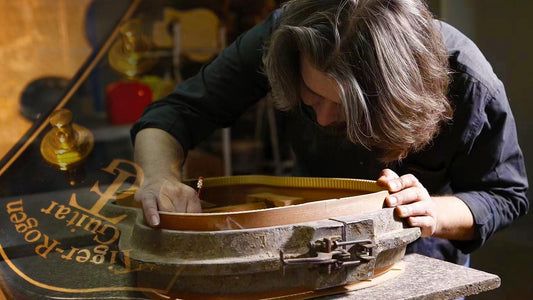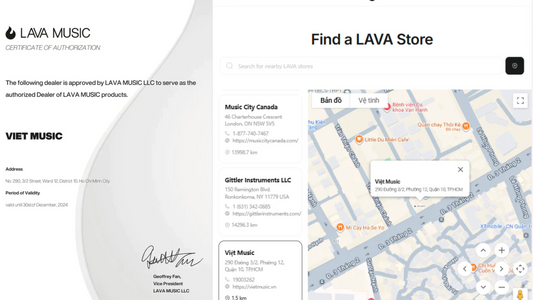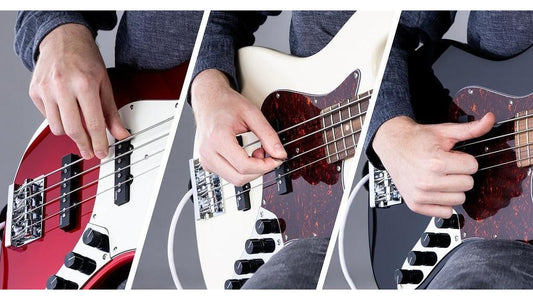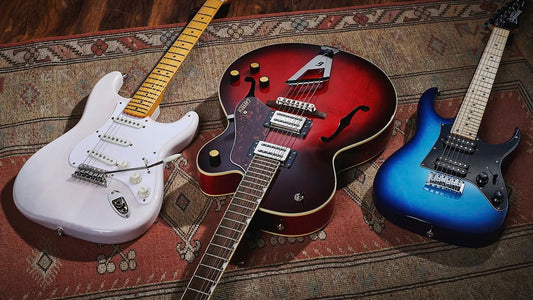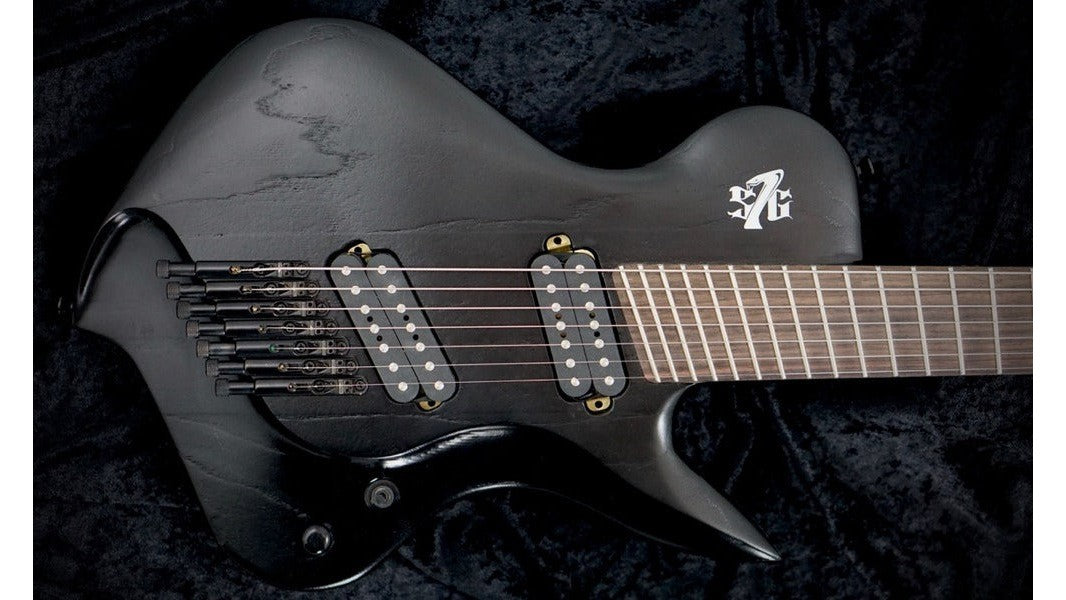
Đàn Guitar Multi-Scale Là Gì?
Ban đầu, đàn guitar nhiều thang âm (multi-scale) có vẻ khó hiểu đối với nhiều nghệ sĩ guitar. Đó là bởi vì chúng trông khá khác so với cây đàn guitar thông thường của bạn, với các phím đàn có hình quạt, nhiều độ dài thang âm trên cùng một cây đàn và các bộ phận khác nhau, chẳng hạn như ngựa đàn và pickup, nghiêng về một góc.
Nhưng những lợi ích của một cây đàn guitar đa thang âm là gì?
Hãy ngồi xuống, thư giãn và đọc tiếp vì bài viết này giải thích mọi thứ bạn cần biết về những thiết kế guitar mang tính cách mạng này. Cuối cùng, bạn sẽ trở thành một người hoàn toàn yêu thích điên cuồng và bạn sẽ có thể nói với tất cả bạn bè của mình về vô số lợi ích của cây đàn đa năng này.
GUITAR MULTI-SCALE LÀ GÌ?
Không còn nghi ngờ gì nữa, những cây đàn guitar nhiều thang âm trông khá lạ, đặc biệt là so với một cây đàn bình thường.
Chúng có các phím đàn nghiêng hoặc 'hình quạt', hướng theo các hướng khác nhau ở hai đầu đối diện của phím đàn. Điều này là do mỗi dây có độ dài tỷ lệ khác nhau (tức là khoảng cách từ ngựa đàn đến đầu đàn), điều này mang lại rất nhiều lợi ích.
Các phím đàn, ngựa đàn và pickup được làm nghiêng nghĩa là dây bass dài hơn và chặt hơn nhiều, trong khi dây treble ngắn hơn.
Những cây đàn guitar thông thường dường như được chế tạo dựa trên ý tưởng rằng cần và các ngón tay của bạn sẽ luôn thẳng/thẳng, vuông góc với các phím đàn. Nhưng đây không phải là như vậy.
Có một góc tối ưu cho cánh tay của bạn để đạt được sự thoải mái tối đa, tùy thuộc vào vị trí của bạn dọc theo phím đàn và các ngón tay của bạn xòe ra một cách tự nhiên khi chơi. Nhiều thang âm được xây dựng xung quanh ý tưởng này . Tất cả đều nhằm cải thiện khả năng chơi và giai điệu.
Tuy nhiên, mục đích chính của công nghệ đa thang âm là – bạn đoán ra rồi – để cung cấp nhiều độ dài thang âm trên cùng một cây đàn guitar. Mời đọc tiếp để tìm hiểu lịch sử và lợi ích của loại đàn độc đáo này.
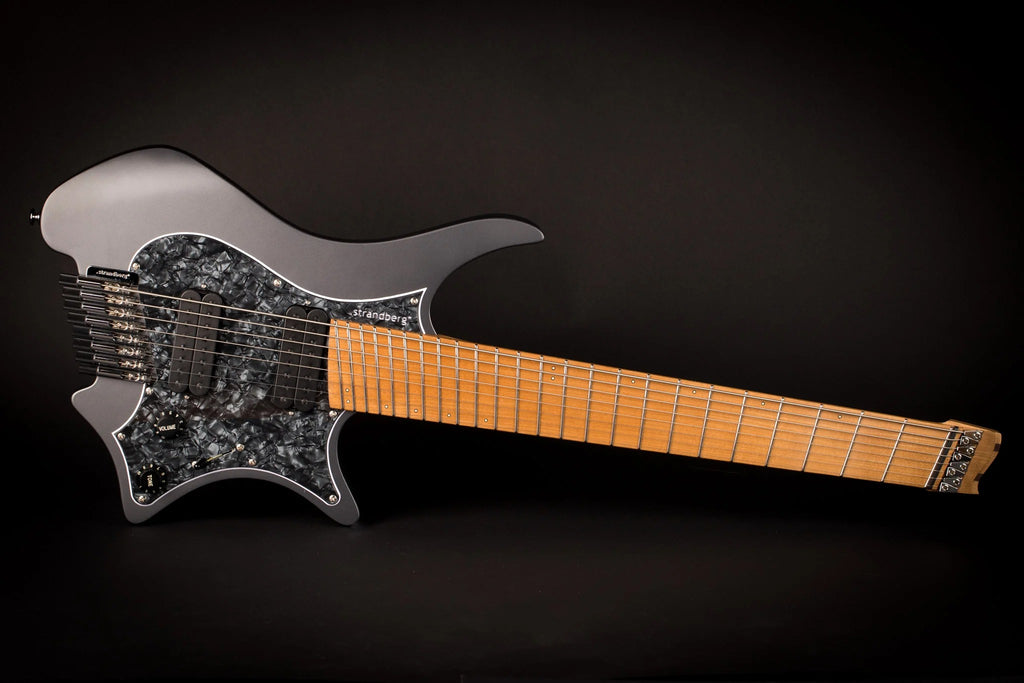
LỊCH SỬ MULTI-SCALE:
Trong nhiều thế hệ, những người chế tạo đàn guitar đã không ngừng tìm cách cải thiện khả năng chơi và hiệu suất của đàn. Từ thiết kế cần đàn mới cho đến hình dáng thân đàn, mọi thứ đã được khám phá để tạo nên những cây đàn guitar mà chúng ta biết và yêu thích ngày nay.
Tuy nhiên, một sự đổi mới vượt trội so với phần còn lại trong những năm gần đây và tôi cá là bạn biết đó là gì!
Trong khi công nghệ đa thang âm có vẻ giống như một sự đổi mới tương đối gần đây, thì lịch sử của nó thực sự đã kéo dài hàng trăm năm.
Các nhạc cụ âm thanh như bandora và orpharion, cả hai đều được phát minh bởi một người đàn ông tên là John Rose vào Thế kỷ 16, được biết là có thiết kế phím đàn hình quạt (mặc dù rất ít mẫu còn tồn tại cho đến ngày nay).
Tuy nhiên, thiết kế này chỉ được cấp bằng sáng chế vài trăm năm sau, bởi EA Edgren, dành riêng cho các nhạc cụ có cần đàn cong.
Sau đó, 77 năm trôi qua và John D. Starrett đã nghĩ ra StarrBoard, một công cụ khá kỳ quặc khác sử dụng nhiều thang âm. Nhưng được sản xuất rất ít trước khi ngừng sản xuất.
Vì vậy, thế giới chắc chắn không xa lạ gì với các nhạc cụ đa thang âm, nhưng chúng có xu hướng chìm trong bóng tối. Chuyển nhanh đến ngày hôm nay và chúng ở khắp mọi nơi! Chà, chuyện gì đã xảy ra vậy?
Đó là nhờ Ormsby! Bên cạnh việc sản xuất những cây đàn guitar chất lượng cao theo tiêu chuẩn nghiêm túc, họ còn được ghi nhận là người đầu tiên phổ biến đầy đủ thiết kế nhiều thang âm trên đàn guitar. Quay trở lại năm 2009, công ty này đã quyết định phá vỡ một bằng sáng chế đã gần hết hạn và sản xuất một số cây đàn guitar điện đa thang âm đầu tiên.
Trên thực tế, Ormsby có lẽ là nhà sản xuất guitar đa thang âm nổi tiếng nhất - nó gần như đã trở thành 'phong cách của riêng họ'.
Nhưng giờ đây, gần như mọi nhà sản xuất đàn guitar lớn, chẳng hạn như Schecter , Jackson và Ibanez , đều tạo ra các mẫu đàn đa thang âm của riêng họ.
NHỮNG LỢI ÍCH CỦA MULTI-SCALE LÀ GÌ?
Lợi ích của việc có độ dài tỷ lệ khác nhau cho mỗi dây là gì?
Xin nhắc lại - chiều dài thang âm là khoảng cách từ cầu đến đai ốc. Một cây đàn guitar tiêu chuẩn có cùng độ dài cho tất cả các dây. Tuy nhiên, trên một cây đàn guitar nhiều thang âm, mỗi dây sẽ khác nhau.
Vì vậy, thay vì một chiều dài tỷ lệ duy nhất, chẳng hạn như 25,5″ (65cm) , bạn sẽ có phạm vi chiều dài tỷ lệ, chẳng hạn như 25,5″-28,2″ (65cm- 72 cm). Dưới đây là một số lợi thế của việc này:
ĐA DẠNG LỰC CĂNG VÀ CHIỀU DÀI HƠN
Điểm có độ dài tỷ lệ khác nhau là gì? Tất nhiên là căng dây! Nếu bạn mở một cây đàn piano, bạn sẽ thấy rằng các dây dày hơn, thấp hơn dài hơn nhiều so với các dây cao mỏng hơn. Đó là bởi vì bạn có được âm sắc rõ hơn, hay hơn nhiều từ các dây thấp khi chúng dài hơn và các dây cao khi chúng ngắn hơn.
Nguyên tắc tương tự áp dụng cho đa thang âm. Chúng cung cấp cho bạn độ dài nhiều hơn ở các dây thấp hơn và ngắn hơn ở các dây cao hơn. Điều này có nghĩa là có nhiều lực căng hơn ở các dây thấp hơn. Điều đó cũng có nghĩa là bạn không cần dây cỡ lớn hơn để điều chỉnh giai điệu như trên một cây đàn guitar thông thường.
NGỮ ĐIỆU (INTONATION) TỐT HƠN
Ngữ điệu rất quan trọng – nó đề cập đến mức độ 'ăn khớp' của từng vị trí phím đàn (ngược lại với từng dây đàn mở). Nổi tiếng là khó, thậm chí có thể là không thể, để có ngữ điệu hoàn hảo trên toàn bộ phím đàn. Các vị trí phím đàn khác nhau sẽ hơi sắc nét hoặc bằng phẳng.
Tuy nhiên, guitar nhiều thang âm chống lại điều này bằng cách cung cấp ngữ điệu được cải thiện. Bạn sẽ thấy rằng mỗi vị trí phím đàn đều nghe siêu chính xác – đặc biệt là khi sử dụng drop tuning. Trên thực tế, khả năng xử lý giai điệu drop tuning cực cao của những cây đàn guitar này là một trong những lý do chính khiến bạn thấy chúng ngày càng xuất hiện nhiều hơn trong bối cảnh metal.
ĐIỀU CHỈNH TỐT HƠN
Với độ căng dây đồng đều trên mặt đàn, bạn cũng sẽ có được độ ổn định khi điều chỉnh tốt hơn từ nhiều thang âm. Một lần nữa, điều này đặc biệt đúng với các mô hình phạm vi mở rộng. Sử dụng các giai điệu thấp hơn với guitar thông thường thường có thể dẫn đến một số giai điệu bị rung nghiêm trọng, với dây thường bị lệch cao độ nhanh. Đa thang âm giúp giải quyết vấn đề này.
KẾT LUẬN
Trên đây là mọi thứ bạn cần biết về guitar đa thang âm. Từ phím đàn hình quạt cho đến cây cầu nghiêng, hy vọng màn sương xung quanh những đổi mới này đã tan đi phần nào.
Mặc dù chúng thường được sử dụng trong nhạc rock và metal, nhưng guitar đa âm giai hướng đến bất kỳ người chơi nào thích một nhạc cụ cực kỳ hiện đại được chế tạo để xử lý tính kỹ thuật. Chúng cũng được yêu thích bởi những người sử dụng drop tuning.
Hiện nay có rất nhiều công ty sản xuất đàn guitar đa thang âm đẳng cấp thế giới. Chúng tôi khuyên dùng Cort KX508MS-II, SubZero Generation Pro và Cort X700 Mutility !
Xem thêm:
